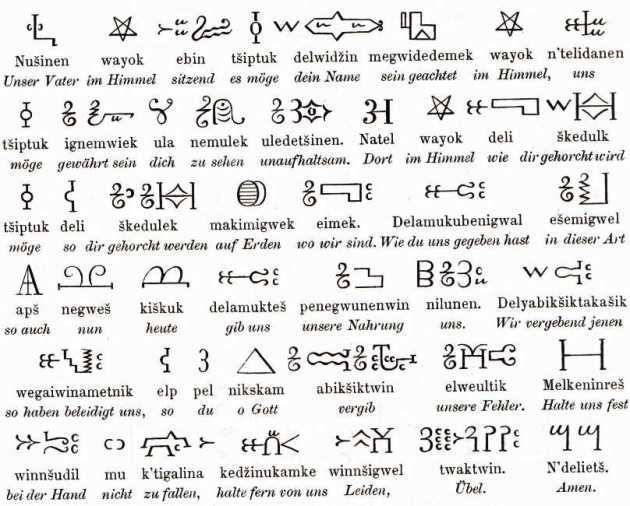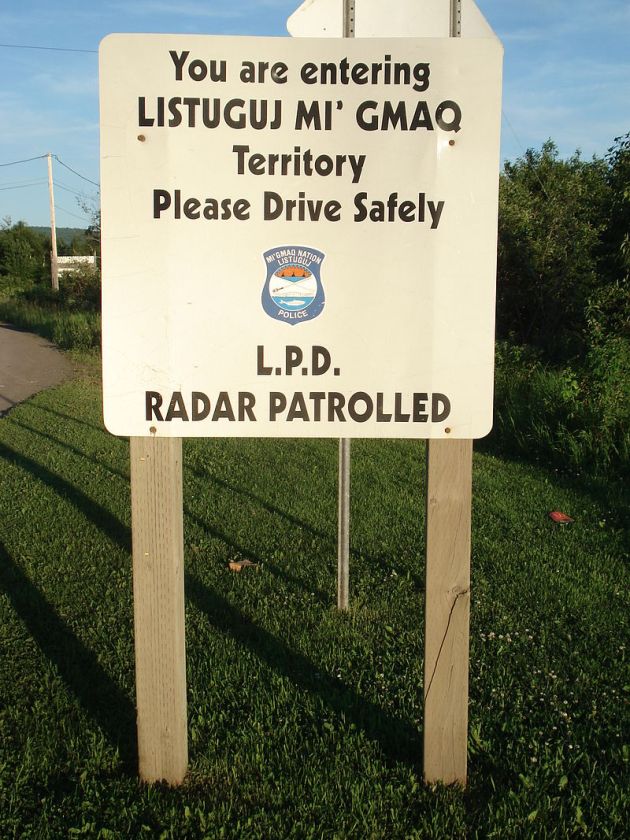This week we are looking at Mi’gmaq, a First Nations Language spoken in Eastern Canada.
More specifically, we are looking at efforts to revitalize the language, and a very promising and encouraging trend among minority and endangered languages : linguists and academics working with and among the community rather than deciding what is best for them.
To that end, this week I am speaking with Carol-Rose Little, linguistics Ph.D. student at Cornell University, and Madelaine Metallic, Mi’gmaq language teacher at Alaqsite’w Gitpu School in Listuguj, QC about efforts currently underway to protect, preserve, and promote the Mi’gmaq language.

[The Mi’gmaq “hieroglyphics” described below.]
CRL : Mi’gmaq is an Eastern Algonquian language of eastern Canada.
MI : Where was it originally spoken?
CRL : Eastern/Atlantic Canada/Newfoundland and Labrador and Maine
MI : Where is it spoken today?
CRL : Eastern QC, Cape Breton, NB, NL
MI : How many speakers are there?
CRL : Numbers are hard to come by…Ethnologue says 8,000 but I would say it is definitely less than half that amount. It is hard to get this kind of survey data.
MI : What makes it unique?
CRL : Mi’gmaq is a polysynthetic language, which basically is to say that each word is composed of many parts. So in one word it is possible to say “I see you” nemul nem=see, -ul = first person acting on second person.
MI : What does it looks like, and what does it sound like?
CRL : Mi’gmaq has a number of different writing systems, there was even once a hieroglyphic system (*cover this* -MI), though that system has not been in use for many years. The orthographies used in communities today all use Latin-based characters [The Mi’gmaq language is written by all communities today using the same alphabet as English].
MI : Are there related languages spoken currently?
CRL : Many languages spoken today are related to Mi’gmaq (all Algonquian languages, e.g. Passamoquoddy-Maliseet, Ojibwe, Blackfoot, Cree).
MI : Now turning to you both, did you grow up with Mi’gmaq as one of your languages, or did you learn it later?
CRL : I began learning Mi’gmaq in the classroom in 2012 and am still learning today.
MM : I grew up with Mi’gmaq as one of my languages. My grandparents have been speaking to me in Mi’gmaq for as long as I can remember, and I have been speaking the language ever since.
MI : And your project “migmaq.org”, how has it been built?
CRL : migmaq.org is meant to be a place where members of the project can share updates and keep updated themselves of what is happening with the work being done by both the community and linguists. It also acts as a place where those interested in Mi’gmaq can go and find resources and references on Mi’gmaq, and how to learn it.
MI : What are the project’s goals?
CRL : The collaboration is a collective effort to bring Mi’gmaq speakers, teachers, and linguists together to develop a deeper understanding of the grammar of the language, create teaching materials, and facilitate the learning, speaking, and promotion of Mi’gmaq.
MI : What is the role of the linguist, and what is the role of the community and its elders in a project like this?
CRL : My role is to help in whatever way possible to build language-learning resources! I’ve helped document course curricula, organize language workshops, contribute to social media campaigns, and record and document the language. I also do fieldwork on Mi’gmaq. For instance, a paper I wrote on Negation will be published soon. This research also feeds into the grammar wiki [Found Here].
MI : What are some of the challenges in a project this big?
CRL : Not getting overloaded with resources! I think at one point we had so many different platforms (apps, social media, computer softwares, websites) to learn Mi’gmaq, we just had to stop and re-evaluate, then cut the programs that were not attracting traffic, and work more on the apps/sofwares/websites that were drawing users.
MI : What are the advantages of modern technology and the internet in revitalizing First Nations languages?
CRL : Accessibility, being able to share resources quickly, and having access to open-source programs that are very attractive to limited budgets.
MI : On the website I see that there is a decision to be active on social media, why is it important to have the community use social media? And how does this impact interactions with the outside communities?
CRL : Social media is a powerful marketing tool. For instance Savvy Simon’s #SpeakMikmaq movement has garnered a lot of support. Many people are posting instagram videos of them speaking Mi’gmaq, even if it is just a word.
MM : Also today, many people are actively involved with social media, so one way to promote the language and reach these people is to share the language through social media. Social media also allows communication between different Mi’gmaq communities, which allows for sharing of resources as Carol-Rose mentioned.
MI : What is a master-apprentice language program? And why do you think it is an important tool?
CRL : The goal of the master apprentice program is to pair a speaker (“master”) up with a learner (“apprentice”), and for the speaker to go about daily routines, but only in the language [In this case Mi’gmaq], forcing the apprentice to use and practice the language in everyday settings. This is an extremely important tool because not only are learners practicing the language, but they are practicing it in culturally and socially relevant contexts, thus learning terminology and phrases related to those activities.
MI : What do you think is the most important thing for the survival of Mi’gmaq in the future?
CRL : Getting young people to learn the language, and use it with each other. Being able to have entire friendships and relationships in the language.
MM : I agree with what Carol-Rose says, but I also think that it is most important for Mi’gmaq people to begin to take initiative in learning their language themselves, and to have the motivation on their own to learn it in order for our language to survive. At the moment we have plenty of resources, and fluent speakers (although, unfortunately, not for much longer) who are willing to help; now is the time where we need the people to be willing to actively use these resources.
MI : If someone wants to learn Mi’gmaq, what do you feel is the best approach, and how should someone get started?
CRL : The best approach is to learn a few basics phrases, and some verb conjugations and just go out and start speaking. Listening to music in Mi’gmaq and learning the lyrics helps with pronunciation (My favourite song). However, I am a linguist, and I’m sure teachers would have many things to add.
MM : I agree with Carol-Rose, a good start would be to learn some simple words and phrases and to practice those. Try to use the new words you’ve just learned as much as possible. In order to learn the language, one must try to immerse themselves in the language. I was also told it was important to begin thinking in the language as much as you can, even if you only have a small vocabulary. If you see a door, don’t identify it to yourself as a “door”, but as a “gaqan”. Also speakers (especially new ones) have to keep in mind that they are still learning, and that they should not be afraid to make mistakes, or to try even if they might not be sure they know. Speakers should realize that they are making an effort to learn, and they should take pride in that, and never feel too embarrassed or shy to keep learning.
MI : What has been your favourite part of being involved in the project?
CRL : I love working with speakers. Mi’gmaq is such a different language than any other I have studied. There is so much to discover and learn from all the structure. It’s such a fun language to talk in as well. I felt so happy after the first time I managed to hold a conversation for 30 minutes in Mi’gmaq. It’s so fun being able to talk to Mi’gmaq speakers in their native language and learn about their rich culture.
MM : I love being able to learn more about my language and to discuss the language with other speakers. I also love hearing the input of others, and working to find different solutions to try for a given issue, and get other people to begin to start speaking their language.

[The Listuguj Mi’gmaq Territory is in the far east of Quebec]
This project is just one example of a growing number of instances where communities are working with academics to preserve and promote their language. Mi’gmaq is a great instance of work being done by people of all backgrounds, and all ages, to create digital resources, fieldwork research, immersive language-learning, and create teaching materials altogether. A large group of people is working very hard, and coordinating a great number of people, and their time, and the results are impressive.
The work that is being done on Mi’gmaq will hopefully be used as an example of how communities and outside experts in various fields can share and learn from, and with, each other. Academics should always ask, coordinate, and work with a community. The results of their combined efforts and various skillsets and knowledge result in a very promising future for both Mi’gmaq specifically, and language revitalization across Canada!
Take care eh,
Michael
